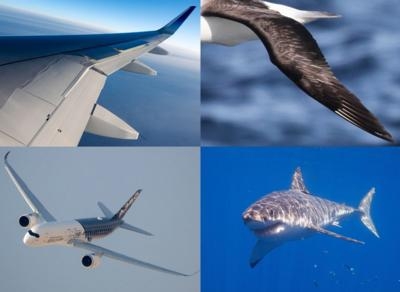Engineers Study The Natural World For Modern Aircraft Design Solutions
The growing science of biomimicry focuses on what humanity can learn from the world, and Airbus engineers are learning quite a lot about efficient solutions for aircraft design that nature has spent millions of years refining.

The traditional method of helping an aircraft cut through the air is to make every surface as smooth as possible, and the study of sharks suggests that there is even more to be done. Sharks are famed for their speed through the water, but rather than being smooth, sharkskin is covered in small, tooth-like riblets.
For the past two years, certain Airbus jetliners in airline service have been fitted with small ‘riblet’ patches – textured surfaces applied to the fuselages and wings that mimic the effect of sharkskin. These test surfaces have helped to demonstrate that the sharkskin concept is highly suitable for long-range aircraft, since its drag-reducing surface is particularly effective during high-speed cruise flight.
The albatross is also of interest to Airbus engineers: these seafaring birds can cover hundreds of miles with hardly a flap of their wings. Airbus engineer Tom Wilson noted that in addition to expertly utilising air currents, the aspect ratio of an albatross’ wings – the measurement of a wing’s span divided by its chord, or width – is significantly greater than the wings of Airbus aircraft today. Seeing the ways in which nature has solved the engineering problems that an aircraft manufacturer faces “gives us the feeling we are asking the right questions,” said Wilson.
Various departments across Airbus are applying the principles of biomimicry to their work and partnering with others to help advance the science. A publicly-funded research project led by Airbus with Lufthansa Technik and Bremer Werk für Montagesysteme continues to explore the use of sharkskin-like material on aircraft. The research team recently developed a technique that allows fully automated, large-area application of a thin riblet structure to wings, and Airbus is considering the introduction of a sharkskin-like coating to the wings and horizontal tails of A350 XWB jetliners beginning in 2020.
The company’s flight physics team recently ran an event with universities to consider a range of biomimicry applications. This includes a range of technologies ranging from sensors and actuation to modelling of aerodynamics.
Airbus is looking to launch incubation projects to see how bio-inspired insights might be further explored. “We want to see how we can learn from the things around us to potentially resolve the issues we face,” said Lee-Ann Ramcherita, Airbus’ technowatch and innovation manager in flight physics. “Understanding how insects, birds or bats detect and respond to fluctuations in the surrounding air flow may potentially help us identify opportunities to apply on our aircraft.”
(Image provided with Airbus news release)
 Classic Aero-TV: Remembering Bob Hoover
Classic Aero-TV: Remembering Bob Hoover ANN FAQ: Follow Us On Instagram!
ANN FAQ: Follow Us On Instagram! ANN's Daily Aero-Linx (05.15.24)
ANN's Daily Aero-Linx (05.15.24) ANN's Daily Aero-Term (05.15.24):Altimeter Setting
ANN's Daily Aero-Term (05.15.24):Altimeter Setting Aero-News: Quote of the Day (05.16.24)
Aero-News: Quote of the Day (05.16.24)



